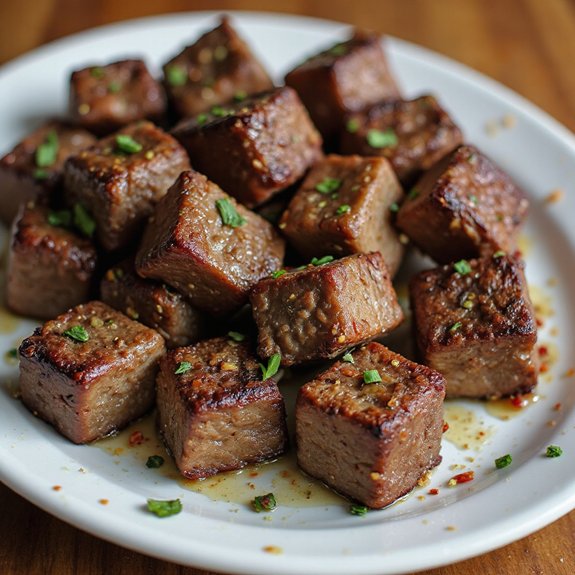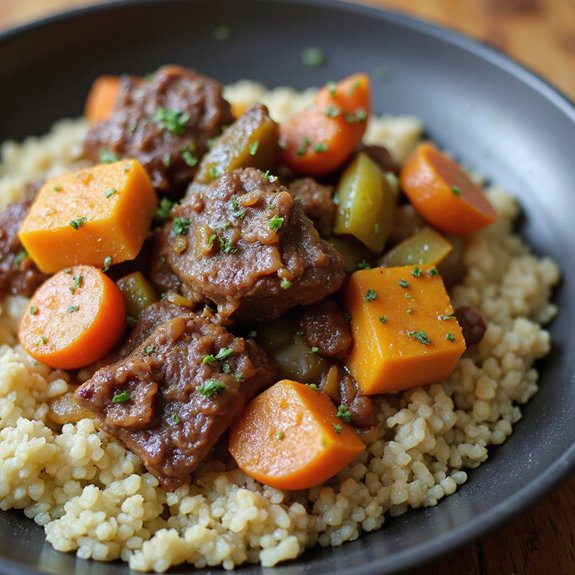You’re about to discover the art of crafting a classic Alfredo sauce.
Start with 4 tablespoons of unsalted butter in a skillet over medium heat. Add 1 cup of heavy cream, stirring gently.
Gradually incorporate 1 cup of freshly grated Parmesan cheese until it melts smoothly.
Season with a pinch of salt, pepper, and a dash of nutmeg. This creamy delight is perfect for pasta, but there’s more to explore in perfecting this sauce.
Kitchen Tools Required
To prepare a perfect Alfredo sauce, you’ll need specific kitchen tools to guarantee the process goes smoothly and the sauce achieves the desired consistency.
Start with a large, heavy-bottomed skillet, essential for even heat distribution and preventing the sauce from scorching.
Use a wooden spoon or silicone spatula for continuous stirring, making sure of a smooth blend of ingredients.
A sharp chef’s knife is vital for finely mincing optional garlic or grating fresh Parmesan.
You’ll need a box grater or microplane for the Parmesan cheese, providing the ideal texture for melting.
Finally, have a measuring cup on hand to portion out the heavy cream precisely.
These tools will guarantee your Alfredo sauce is creamy, velvety, and perfectly seasoned every time.
Recipe
Alfredo sauce is a classic Italian sauce known for its creamy and rich flavor, perfect for topping pasta dishes.
Originating in Rome, Alfredo sauce combines simple ingredients to create a luxurious dining experience.
The sauce’s key components — butter, heavy cream, and Parmesan cheese — meld seamlessly to produce a smooth, velvety texture that enhances any pasta dish.
Whether you’re planning a romantic dinner or a comforting family meal, Alfredo sauce adds a gourmet touch to your culinary creations.
To begin preparing Alfredo sauce, start by gathering fresh, high-quality ingredients.
The richness of the butter, the creaminess of the heavy cream, and the sharpness of freshly grated Parmesan cheese are essential for achieving the best results.
A pinch of salt and black pepper can enhance the flavor, while optional additions like garlic or nutmeg can provide extra depth.
With these ingredients at hand, you’re ready to create a sauce that will elevate your pasta dish to new heights.
Ingredients:
- Butter
- Heavy cream
- Parmesan cheese
- Salt
- Black pepper
- Garlic (optional)
- Nutmeg (optional)
In a large skillet over medium heat, melt the butter until it’s fully liquefied and slightly bubbling.
Gradually pour in the heavy cream while stirring constantly to prevent the mixture from separating.
Let the cream heat through completely before slowly incorporating the grated Parmesan cheese, continuing to stir until the cheese is fully melted and the sauce thickens to your desired consistency.
Season the sauce with salt and black pepper to taste. If desired, add a pinch of nutmeg or minced garlic for an enhanced flavor profile.
Once the sauce is ready, pour it over your freshly cooked pasta, toss to coat evenly, and serve immediately for the best experience.
For ideal results, always use freshly grated Parmesan cheese, as pre-grated varieties may not melt as smoothly, leading to a less creamy sauce.
Be mindful of the salt content, especially if your cheese is particularly salty.
If your sauce becomes too thick, simply thin it out with a little reserved pasta water.
When reheating leftovers, do so gently over low heat to prevent separation.
Remember, Alfredo sauce is at its best when enjoyed fresh, so try to make only as much as you plan to eat in one sitting.
Cook & Prep Time
Preparing this classic Alfredo sauce recipe requires careful attention to both cook and prep times to guarantee a seamless cooking experience.
Begin by allocating approximately 5 minutes for preparation.
This involves gathering 1/2 cup of unsalted butter, 1 cup of heavy cream, and 1 cup of freshly grated Parmesan cheese.
Make certain your ingredients are ready before heating.
Next, dedicate about 10 minutes to cooking. Melt the butter in a skillet over medium heat, making sure it doesn’t brown.
Gradually incorporate the heavy cream, stirring continuously to maintain a smooth consistency.
Once the cream is heated, slowly add the Parmesan cheese, stirring until fully melted.
Season with salt and pepper to taste. Your Alfredo sauce will be ready to serve immediately, ensuring peak flavor and texture.
Cooking Steps
Begin by melting 4 tablespoons of butter in a skillet over medium heat until it starts to bubble.
Gradually stir in 1 cup of heavy cream, ensuring a smooth mixture, then slowly incorporate 1 cup of freshly grated Parmesan cheese until the sauce thickens.
Season with 1/4 teaspoon of salt and a pinch of black pepper, and for an added layer of flavor, consider a small pinch of nutmeg.
Step 1. Melt Butter in Skillet

To start making the Alfredo sauce, melt 4 tablespoons of unsalted butter in a large skillet over medium heat.
Use a skillet with a wide base to guarantee even heat distribution. As the butter begins to melt, gently swirl the skillet to coat the bottom evenly.
It’s vital not to let the butter brown, so maintain a close watch. If you notice any browning, slightly reduce the heat.
The goal is to achieve a smooth, melted consistency without any coloration.
Once the butter is fully melted, it should appear golden and slightly bubbling. This stage is essential for creating a creamy base.
Ascertain no solids remain unmelted, as this will affect the sauce’s texture. You’re now ready for the next step.
Step 2. Add Cream While Stirring
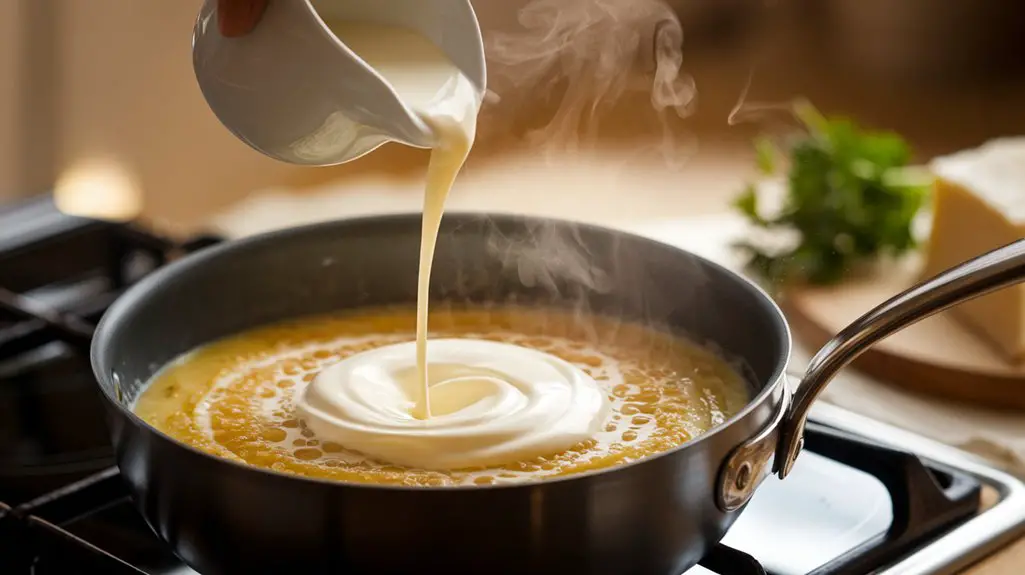
Pour 1 cup of heavy cream into the skillet, stirring continuously with a wooden spoon or whisk.
Maintain a steady motion to guarantee the cream integrates with the melted butter, preventing separation.
Keep your heat at medium to gently warm the mixture without scalding.
Observe as the cream begins to incorporate, transforming into a smooth, luscious base, promising rich flavors.
| Step | Emotion |
|---|---|
| Stir | Anticipation |
| Blend | Satisfaction |
| Warm | Comfort |
| Transform | Delight |
As you stir, watch for the first bubbles indicating the cream is heated through.
This stage is critical for achieving the desired velvety consistency.
Your patience will be rewarded with a sauce that embodies indulgence, setting a foundation for the remaining ingredients.
Step 3. Gradually Incorporate Parmesan Cheese
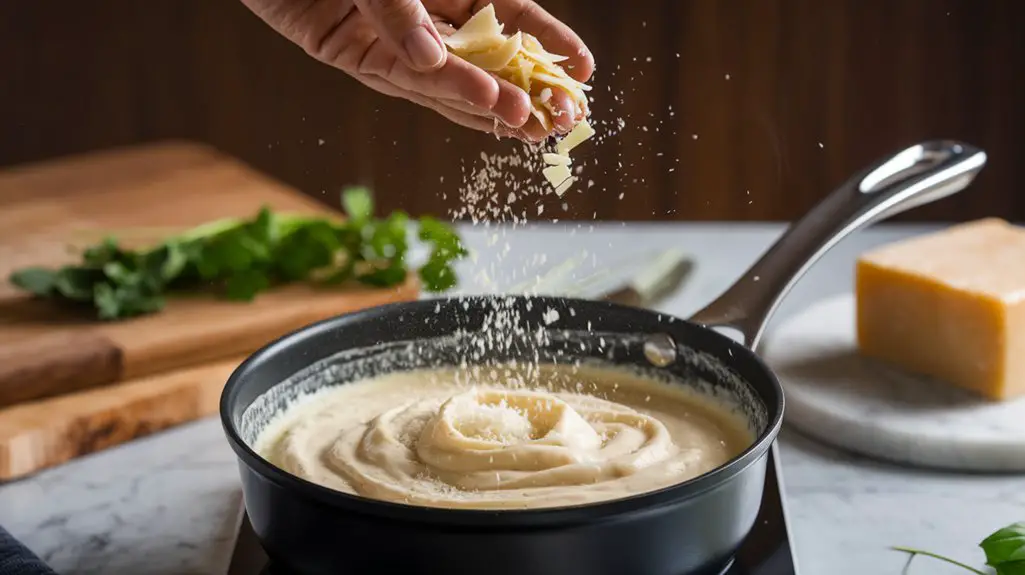
Now that the cream has reached the perfect warmth, gradually add 1 cup of freshly grated Parmesan cheese to the skillet.
Stir constantly using a wooden spoon or spatula to guarantee even melting and integration. Maintain medium-low heat to prevent scorching.
Add the cheese in small increments, about 2 tablespoons at a time. Allow each portion to melt completely before adding more.
This technique helps achieve a smooth, velvety consistency without clumps.
If the sauce appears too thick, incorporate a tablespoon of reserved pasta water to adjust the texture.
Continue stirring until all the cheese is fully melted and the sauce is silky.
Remember, consistency is key, so keep a steady hand as you blend the cheese into the cream.
Step 4. Season With Salt and Pepper
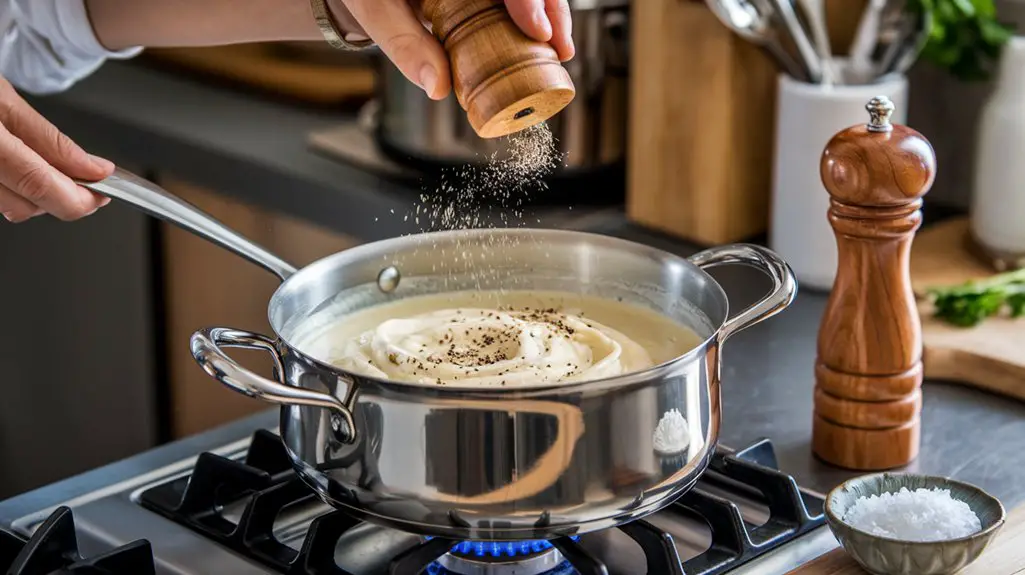
As you approach the final steps in crafting your Alfredo sauce, it’s essential to season it with precision.
Begin by tasting the sauce. Gradually add 1/4 teaspoon of kosher salt, stirring thoroughly. This guarantees the salt disperses evenly.
Taste again and adjust if necessary, remembering that Parmesan can add significant saltiness.
Next, grind fresh black pepper directly into the sauce, starting with 1/8 teaspoon. Stir well to integrate.
The pepper should enhance, not overwhelm, the sauce’s creamy profile.
Continue to taste and adjust until the seasoning is balanced to your preference. Remember, salt and pepper are powerful; add them incrementally.
Once you’re satisfied with the flavor, your Alfredo sauce is ready to complement your favorite pasta dish.
Step 5. Add Nutmeg for Flavor
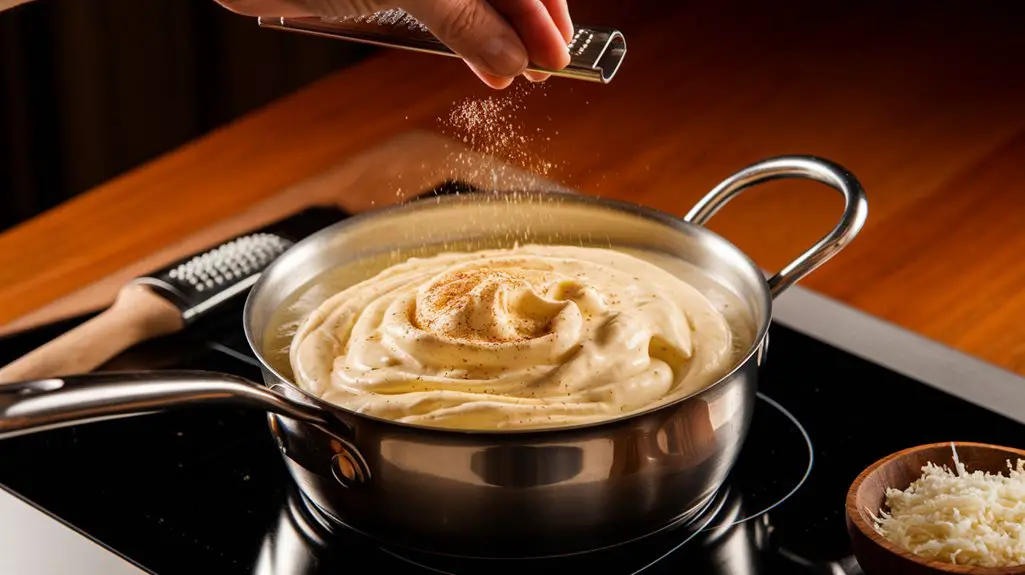
After ensuring your Alfredo sauce is seasoned with salt and black pepper to your liking, enhance its depth and warmth with a subtle hint of nutmeg.
Measure precisely 1/8 teaspoon of ground nutmeg for ideal balance. Sprinkle it evenly over the sauce while it’s still on low heat.
Use a whisk or spoon to incorporate the nutmeg thoroughly into the creamy mixture, ensuring even distribution.
Stir continuously for about 30 seconds to allow the nutmeg to infuse its delicate aroma.
Taste the sauce to confirm the nutmeg’s subtlety complements the other flavors without overpowering them.
If the flavor is just right, remove the sauce from heat promptly. Serve immediately over your favorite pasta for best results.
Nutrition Information
A serving of classic Alfredo sauce, typically about 1/4 cup, delivers a rich nutritional profile that should be considered when planning meals.
Each 1/4 cup serving contains approximately 220 calories, owing largely to its high-fat content.
You’ll find around 22 grams of fat, with 14 grams of that being saturated fat. The sauce provides about 6 grams of protein, primarily from Parmesan cheese.
Sodium content stands at 400 milligrams, so be mindful of salt intake from other meal components.
Carbohydrates are minimal, generally under 2 grams per serving.
It’s important to balance this indulgence with lighter, nutrient-dense foods to maintain a healthy diet.
Consider portion sizes and meal frequency to manage calorie intake effectively.
Final Thoughts
Simplicity is the essence of creating a perfect Alfredo sauce, encapsulating the harmony of its ingredients.
Begin with unsalted butter—4 tablespoons—melting it in a skillet over medium heat.
Add 1 cup heavy cream, stirring continuously to guarantee a smooth blend. Gradually incorporate 1 cup freshly grated Parmesan cheese.
Stir constantly until the cheese melts completely, resulting in a creamy, unified sauce.
Season with 1/4 teaspoon salt and 1/8 teaspoon black pepper, adjusting to taste.
Frequently Asked Questions
Can Alfredo Sauce Be Made Without Heavy Cream?
Yes, you can make Alfredo sauce without heavy cream. Substitute it with whole milk or half-and-half. Use 1 cup of whole milk, 2 tablespoons of flour for thickening, and follow the same cooking instructions for consistency.
How Can I Make Alfredo Sauce Gluten-Free?
To make Alfredo sauce gluten-free, replace regular pasta with gluten-free pasta. Use 1 cup heavy cream, 1/2 cup unsalted butter, 1 cup freshly grated Parmesan, salt, and pepper. Stir until smooth, then toss with gluten-free pasta.
What Are Some Vegan Alternatives for Alfredo Sauce Ingredients?
You’ll need to replace butter with 2 tablespoons of olive oil, use 1 cup of coconut cream instead of heavy cream, and substitute 1/2 cup nutritional yeast for Parmesan. Blend until smooth, season with salt, pepper.
How Do I Store Leftover Alfredo Sauce?
Refrigerate leftover Alfredo sauce in an airtight container within two hours of cooking. Use within 3-4 days. Reheat gently over low heat, stirring continuously. If it thickens, incorporate 1-2 tablespoons of milk or pasta water.
Can I Add Vegetables or Proteins to Alfredo Sauce?
You can add vegetables or proteins to Alfredo sauce. Sauté 1 cup diced chicken or shrimp until cooked. Incorporate 1 cup steamed broccoli or spinach. Stir into the sauce, ensuring even distribution. Adjust seasonings if necessary before serving.




